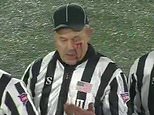New treatment is a step forward for children born with club feet
Children born with club feet would once have faced major surgery and months of painful rehabilitation for a chance to walk normally.
But today a new non-invasive treatment that uses a special pair of shoes is proving remarkably successful.
Club feet - in which the ankle is twisted, the foot points down and the soles inwards - affects one in 800 babies. In two-thirds of cases both feet are affected. The cause is not known, although it can hereditary. If untreated, the child will be unable to walk unaided.

Cured: Mason, aged three benefited from the new multi-stage procedure designed to correct children born with club feet
The new multi-stage procedure, pioneered by specialists at Coventry University Hospital, involves a minimally invasive operation under local anaesthesia to release the Achilles tendon, which anchors the calf muscle to the heel. This tendon is especially tight in those with club feet.
Following this the feet are encased in a cast, from below the knee, for three weeks while the tendon heals. The cast is made from a special flexible plaster-like substance that can be unwrapped like a bandage. Once a week the cast is removed, and the feet manually manipulated to move them gradually into the correct position. The cast is then replaced to hold the limb in position.
Traditionally, babies would have been placed in plaster from hip to toe, but this further affected normal development. In the new process the knee is free to flex so muscle development is not hindered.
When the cast is removed, special lace-up shoes held in place by a metal bar are worn, holding the feet in the corrected position. The feet stay in the boots for 23 hours every day for three months and then at night for a further three to four years.
Consultants at Coventry treat up to 20 babies with club feet each week with the method. 'Before this new approach, children would undergo major surgery when they were nine months old.

From birth: Club feet - in which the ankle is twisted, the foot points down and the soles inwards - affects one in 800 babies
'The foot was essentially taken apart and then put back together, stabilised with wires,' says Dr Irene van der Ploeg, consultant paediatric orthopaedic surgeon. 'Recovery from this is very painful and, of course, there are risks of infection.
'This method meant walking was delayed for a long time and because of this sometimes patients would never walk completely normally. Now we begin treatment one week after birth, placing the feet in the cast to begin moving them while the bones are still soft. After six weeks they have minor surgery on their foot and after a further three weeks in a cast they wear the boots.
'Not only is the process far less painful and risk-free, but the child also ends up with a more flexible foot.'
One patient to have benefited is three-year-old Mason Fairbrother. His mother, Lisa, 21, from Coventry, first knew something was wrong when she had a routine ultrasound scan five months into the pregnancy.
'I was devastated, obviously, and cried my eyes out,' she says. 'But then you just have to take a deep breath and get on with it. There is no history of club feet in the family, so it was a complete shock. But the doctors assured me it could be fixed almost as soon as he was born.
'The cast didn't seem to bother him, as he was able to kick and bend his legs pretty normally. And I made sure he wore his boots continually.
'He only had to wear them at night by the time he was starting to haul himself up and crawl, and he didn't mind as he didn't know any different.
'By the time he was walking, his feet looked just like those of any other little boy. Now he runs around like any normal three-year-old.
'He loves sport, especially football, and he can kick a ball as well as anyone. I must admit I shed a tear or two - but for all the right reasons - when the doctors said he didn't need to wear the shoes any more, and it is clear to see how perfect his legs are now.
'I think there will be a few more tears when he plays in his first football match, too.'
Most watched News videos
- Scottish woman has temper tantrum at Nashville airport
- Tesla Cybertruck explodes in front of Trump hotel in Las Vegas
- Mass panic as New Orleans attacker flies down Bourbon street
- Shocking moment zookeeper is fatally mauled by lions in private zoo
- Horrific video shows aftermath of New Orleans truck 'attack'
- Meghan Markle celebrates new year in first Instagram video
- Tesla Cybertruck burns outside Trump hotel in Las Vegas
- See how truck that drove into crowd made it through police barrier
- Cheerful Melania Trump bops to YMCA at Mar-a-Lago NYE bash
- New Orleans terror attack suspect reveals background in video
- Plane passenger throws drink at flight attendant in boozy fight
- Horrifying moment yacht crashes into rocks and sinks off Mexico coast



















































































































































































































































































































































































